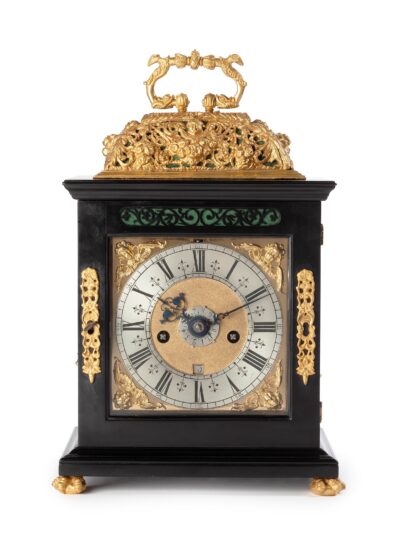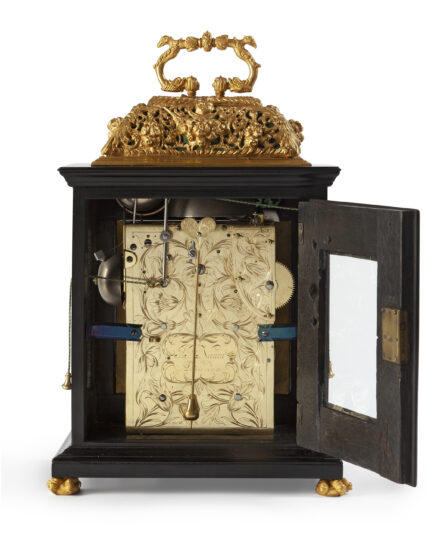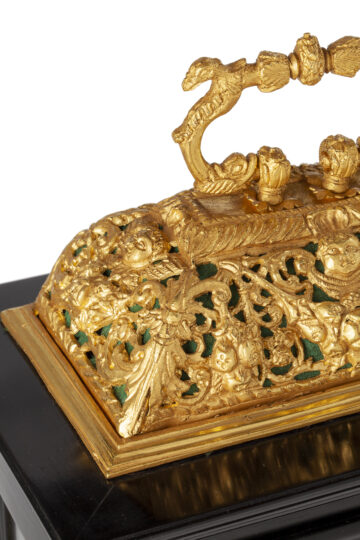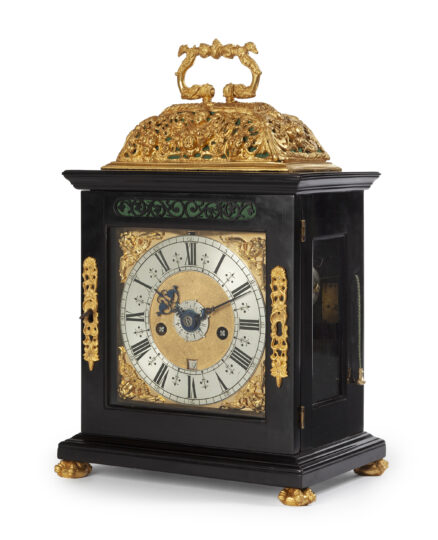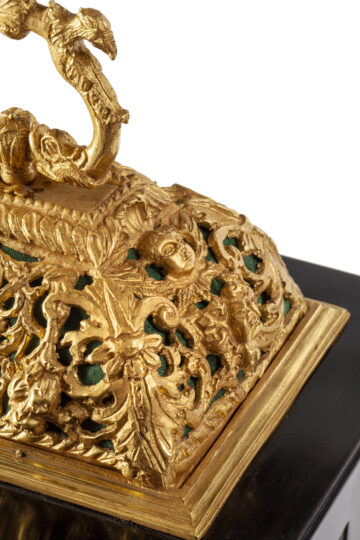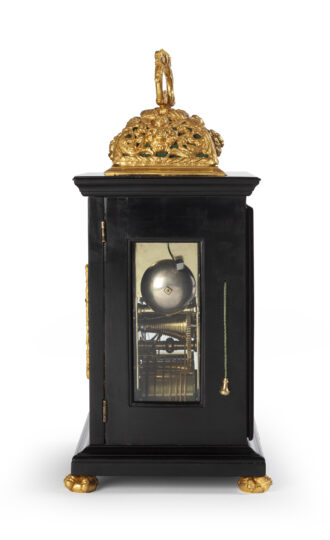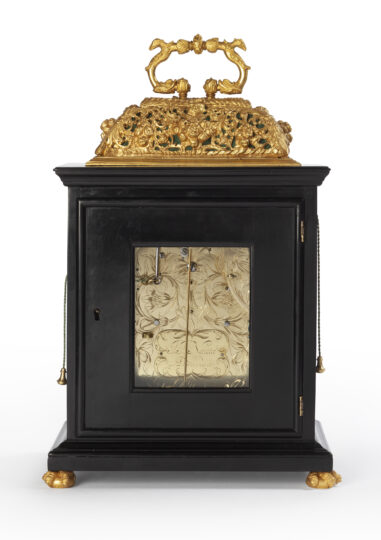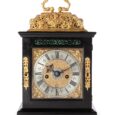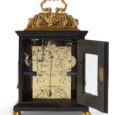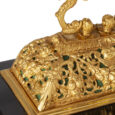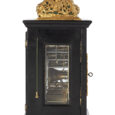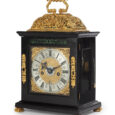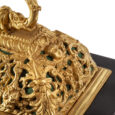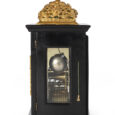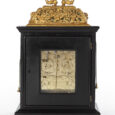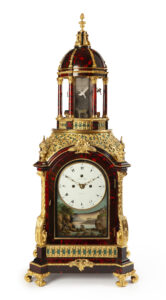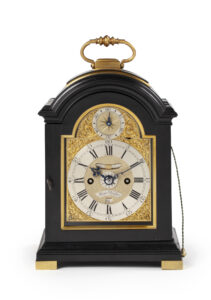BRACKET CLOCK J.J. Nauta Amsterdam – Joseph Norris Amsterdam Ca. 1680 Netherlands/England
M&R16
BRACKET CLOCK
Signed: J.J. Nauta Amsterdam – Joseph Norris Amsterdam
Circa 1680
Netherlands
Movement
The clock has an eight-day spring-driven double fusee movement consisting of going and striking trains. The going train has a verge escapement with a short pendulum. The rack striking indicates the hours fully and half hours with one stroke on a bell. In addition, the movement has pull repeat, sounding the quarters and hours last struck on three bells. Finally the movement has a spring-driven alarm, wound at the back. Originally the movement was signed on the elaborately floral and leaf engraved backplate in an engraved cartouche Joseph Norris Amsterdam. This signature was obliterated and instead an engraved plaque was screwed on the back with the exact shape of the engraved cartouche signed J.J. Nauta Amsterdam.
Dial
The square brass dial has a silvered chapter ring with Roman hour, half-hour, quarter-hour, Arabic five minute and minute divisions. In the matted centre is a date aperture above the VI, in which the date is shown with black Arabic numerals. Behind a fine pair of blued steel hands is a silvered Arabic alarm disc. There is a S/N slide above the XII to switch off the striking. The four corners are embellished by gilt brass winged-cherub spandrels.
Case
The ebonised pearwood basket-top case is embellished by pierced gilt brass ornaments. The pierced gilt cast-brass basket reveals scrolling leaf and floral motifs, as well as masks. It is surmounted by a carrying handle with grotesque animal heads on the top corners. The clock rests of four gilt cast brass claw feet.
Duration 1 week
Height 38 cm.
Width 25 cm.
Depth 17 cm.
*Price on request
Note:
Joseph Norris was active as a clockmaker in Amsterdam from 1675 to 1692. Robert Seignior, who died in 1686, supplied Norris with movements. The present movement resembles a clock depicted in Dawson et al. 1994 signed by Seignior. This implies that the clock must have been made between 1675 and 1685. Later the clock must have come into the hands of the Dutch maker Jan Jacobus Nauta.
Literature
E. Morpurgo, Nederlandse Klokken- en Uurwerkmakers vanaf 1300, Amsterdam, 1970, p. 91.
H.M. Vehmeijer, Antieke Uurwerken, een familieverzameling, Houten, 1994, p. 611.
P.G. Dawson, C.B Drover and D.W. Parkes, Early English Clocks, Woodbridge, 1994, pp. 358 and 359.
Nauta
Jan Jacob Nauta was active as a clockmaker in Amsterdam around 1720. He was a master clockmaker, who had his workshop in Gasthuismolensteeg. Klaas Pieterszoon Boeken became his apprentice at the age of eleven (municipal archive Amsterdam).
Norris.
Joseph Norris was born in Abingdon near Oxford in 1650, the brother of Edward Norris (1637-1726), who was twelve years his senior. At the age of 12 Joseph was apprenticed to his brother for a period of eight years. He survived ‘The Plague’ and ‘The Great London Fire’, respectively in 1665 and 1666. Because of the fire the two brothers had to leave The Crossed Keys in Lothbury and move to Dove Court in London. After the peace treaty between England and the Netherlands in 1674 Joseph went to Amsterdam and settled there. It may have been due to the fact that his former mentor Ahasuerus (I) Fromanteel had been there since 1667; Norris did not return to England until 1692. Several authorities are of the opinion that during his Dutch period Fromanteel (I) did not produce longcase clocks with a long pendulum and anchor escapement in Holland, but that he imported them ready-made from London. He therefore concludes that Joseph Norris was the first to make such clocks with a ’Royal Pendulum’ in Holland, starting in or immediately after 1675.
Joseph Norris lived near the Beurs (the Exchange) on Damrak in Amsterdam, where he also had his workshop. In 1677 he married Alicia Arnold (from Tonstell probably Tunstall, Kent, England) in the English Reformed Church. He quickly became one of the city’s leading clockmakers. In 1692 he returned to Abingdon, where he held numerous prominent positions in public and clerical life until his death in 1726. During this period he made clocks in London, in his brother’s workshop in Dove Court. It will be clear from the preceding description that clocks signed ’Joseph Norris London’ must date from either the pre-Amsterdam years 1670-1675 or from the post-Amsterdam years 1692-1696, the last year of his membership of the Clockmakers Company; clocks signed ‘Joseph Norris Amsterdam’ are to be dated between 1675 and 1692.

